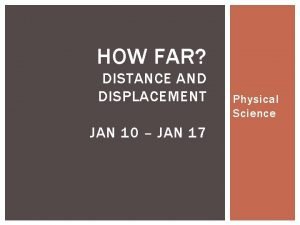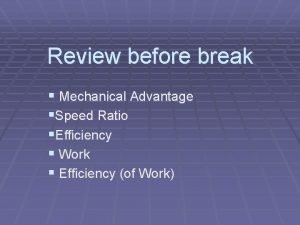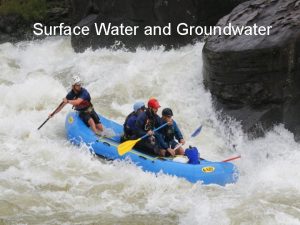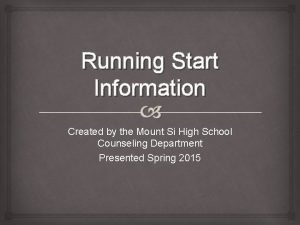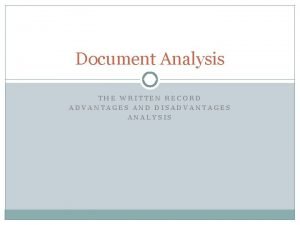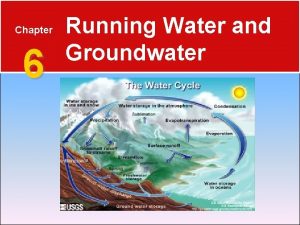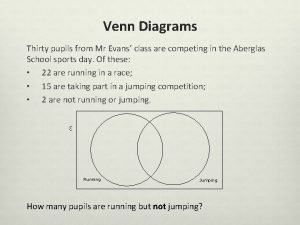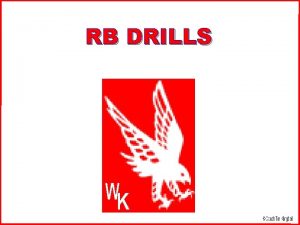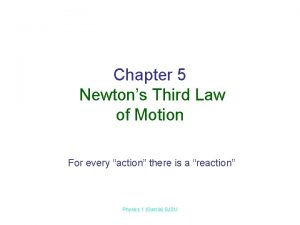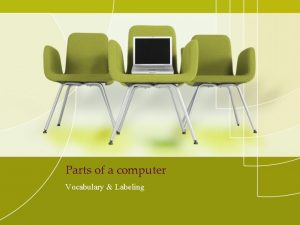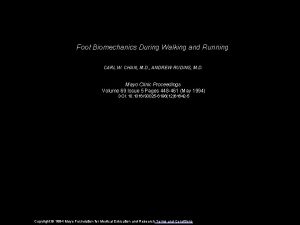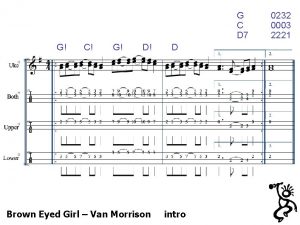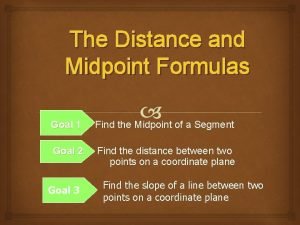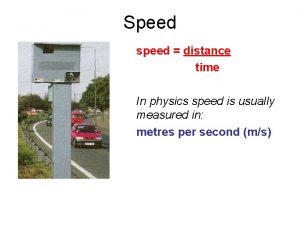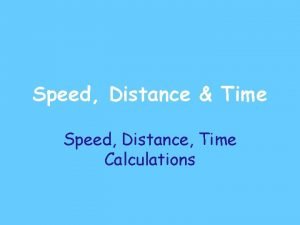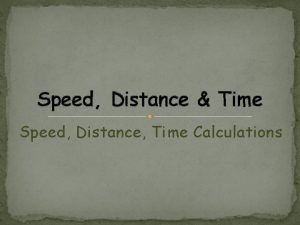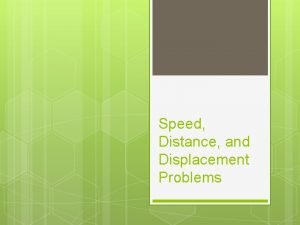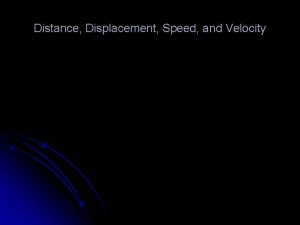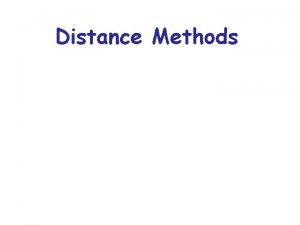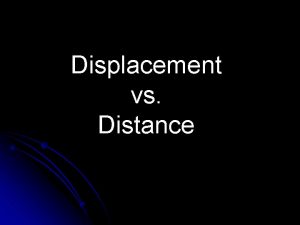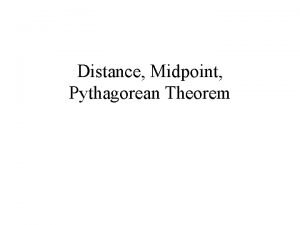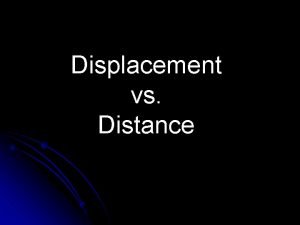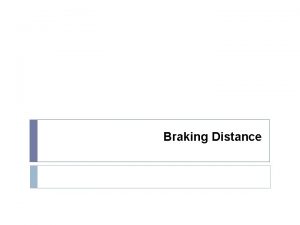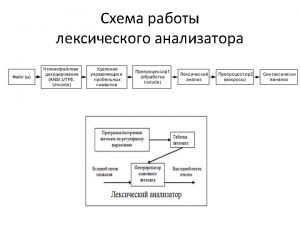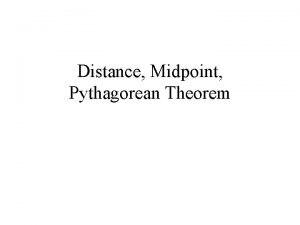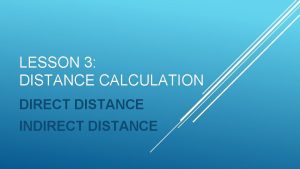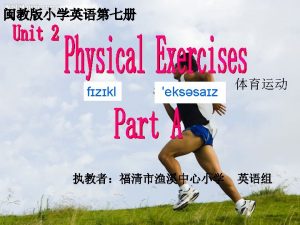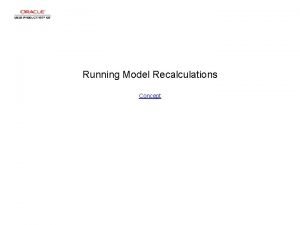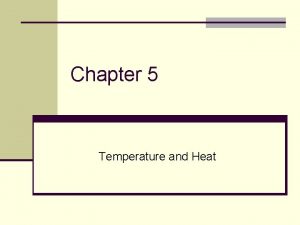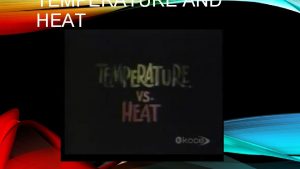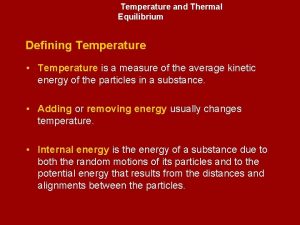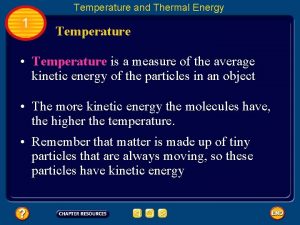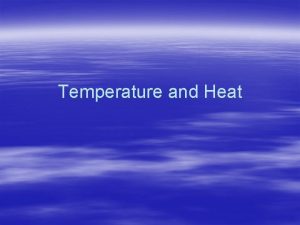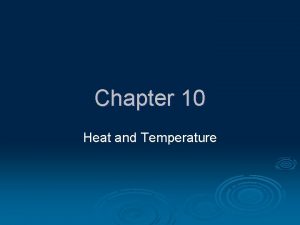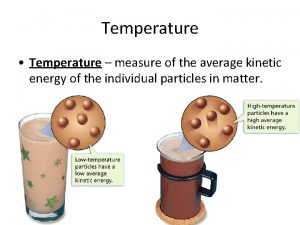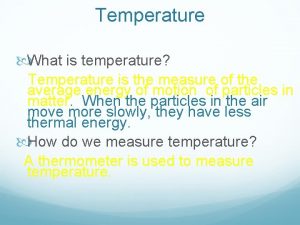Running a Temperature Distance Running thermoception and temperature





























- Slides: 29

Running a Temperature: Distance Running, thermoception and ‘temperature work’ John Hockey University of Gloucestershire, UK.

n n n Hockey, J & Allen-Collinson, J. (2017) Running a Temperature: Sociological –phenomenological perspectives on distance running, thermoception and ‘temperature work’, in Andrew Sparkes (ed) Seeking the Senses in Physical Culture, 42 -62, London: Routledge. This talk based on the chapter. Pre-print copies free from the Professor! https: //www. researchgate. net/profile/Jacquelyn_Allen. Collinson

The research n n n Based on: a) 2 -year collaborative autoethnography by 2 distance runners & b) a 3 year solo phenomenological study Researchers: 49 & 31 years’ experience of running Running 6 -7 days a week, often twice daily when younger and involved in serious athletic competition. In Garfinkel’s (2002) phenomenologically based terms both of us fulfilled the ‘unique adequacy requirement’ of being distance runners. Thus accumulating a sensory based ‘stock of knowledge at hand’ (Schutz, 1967). The research initially conceived during a period of mutual injury. Developed rapidly into how distance running was accomplished, thus about the craft practices of running.

Theoretically research situated within sociological phenomenolgy (Schutz, 1967), and phenomenological ethnography (Katz & Csordas, 2003). Currently little sociological literature on temperature generally or specifically in sport (Vannini & Taggart, 2014) 2. Aim: to investigate ‘embodied consciousness’ which is socially permeated via impact of cultural and sub-cultural forces upon body. 3. This consciousness constituted by perceptions, emotions, and sensations. Runners then develop a particular ‘somatic mode of attention’ (Csordas, 1993) which encompasses temperature. 1.

n n n Phenomenology as theory but also as Method. Researchers following Husserl (1989) thus: Firstly, engage in epoche an attempt to suspend the natural attitude so as to capture how things are ‘according to the experience’ (Overgaard, 2010). Secondly, identify the essential characteristics of a phenomena, the eidos via a process of reduction. To identify structures or patterns of subjective, sensory experience of running.

n n Thermoception as temperature awareness is vital for survival as it helps homeostasis (Ong, 2012). Humans can cope with only small temperature ranges. Problem of isolating distinctive components of sensory perception, as there is much inter-sensory perception of phenomena (Merleau-Ponty, 2001).

Theorisation of thermoception: As specialised sense of touch (Guerts, 2002) which is proximal. Also as a distinct sensory perception (Ong, 2012, Potter, 2008). As a sense of internal energy a vital force. I will depict both using ethnographic data

n n n The data revealed we conceptualised this internal energy as a form of HEAT. Why not cold? Cold is inert, flat. When cold it is difficult physically to generate movement, momentum, impetus – which are vital to successful distance running. Interesting subcultural concept within UK distance running, which is to “ Blow up”. Usually used in cases of pace error, when the internal energy source vanishes suddenly. So even in the case of its depletion it is conceptualised as heat.

Energy perceived as felt inner heat The ‘heat of vitality’ incorporating physiological, psychological and interactional dimensions. A force which one uses to propel one forward. Runners are very aware they need it, and need to feel it.

n As soon as I get in the car and leave the campus, I crack on the radio. If I can’t find a station with some decent rock, it’s on with the Zep or Coverdale tape. I need something with a rocksteady beat, something with a lot of whack to it, something you can feel deep down… It’s an energizing thing really, such a change from being so static and sedentary at work, so mind-orientated. I really need that change of tempo, to wake me up, to get everything moving so as to be ready to pull on the training gear as soon as I get home. It’s like I have to prepare my muscles and also get myself focused for the sensations of running. A lot of academic thought is abstract, it’s mediated and disembodied, but distance running demands right-on physicality from the very first step, when the elements hit you… (RS 1 Log 2)

n n n When ‘going well’ energising heat is high, but when ‘going badly’ it is experienced as low. Internal force then contingent. Felt via sensory perceptions: limbs, hips, lungs and ‘centre’. Somatic indicators of inner force or its lack. E. g Breathing ragged or rhythmic. Internal heat perceived as phenomena.

n Lots of ‘oomph’ today! Not exactly effortless, but got up the hills easily and that’s always the prime sign of good training. In some ways it’s all in the quads (quadriceps). You ask them the question when you get to the bottom, ‘ready? ’ and then you try to surge up, and then you find out if it’s there, and like today it was. It’s sort of having a bank balance and being in credit physically, you draw on it, and when it’s there you can feel the power. (RS 1 Log 1)

All over the place this morning, I could not get it together at all. J kept on looking at me anxiously. I could tell straight away it was going to be a duff (bad) run. Felt very hollow right from the first mile, no push, a real slog all away around the route. The biggest sign for some reason (who knows? ) was my breathing. I could not believe the noise I was making as an experienced runner. It was like I was some kind of beginner again. As I passed by folk having a picnic on the park, they actually looked up suddenly. They must have thought I was bound for a cardiac arrest… (RS 1 Log 1)

n n n Analysis of data revealed complex shifting combination of presence of heat of vitality and its absence, sometimes within a single training session. Difficult to identify causation of fluctuation at phenomenal level as shifting combination of: terrain, elements, volume, intensity, life events… Paradox: considerable fitness but can feel devoid of internal energy, the heat of vitality.

n We have been training hard in preparation for doing some races in the North. We know we are fit, we know we are getting ready. The problem is most of the time we both feel dog tired, we can’t feel the edge, there is no buzz, no élan, no - I guess – ‘spring’ to the running. We are just grinding it out mile after mile, night after weary, winter night, at the pace we need to. Analytically, it’s curious. Practically we can only hope IT comes back when we reduce training prior to the races. May the Force be with you? ? (RS 1 Log 3)

n n n Various kinds of reification of this internal vital heat, most habitual: ‘IT’, ‘Gas’(olene) with its embodied container often being referred to as a ‘tank’. Performative utterances (Turner, 1975): ‘IT was not there today’, ‘No gas in the tank’ So feelings of inner heat as a distinct perceptual mode in distance running. Feeling its ‘vibration’ (Merleau-Ponty, 2001). Age diminishes it!

n n So to Thermoception as Proximal Touch Heat and Cold as a form of haptic. Distance running places demands of terrain, distance, speed. Then also the touch of temperature upon running bodies impacts upon performance UK impacted by 3 weather systems, so weather unpredictable, difficulties in adaption.

n Saturday. End of the training week and our day off tomorrow. The weather has been up and down all week. We had tee shirts and longs (running tights) on the first couple of days when it was cold for May, then ‘up we go’, and we put shorts on midweek and by Thursday Jaqui had even switched to a summer vest. Now today, we’re both back to the kit we had on at the start of the week. Crazy – you just never know in ‘Blighty’ (affectionate term for ‘England’)! (RS 1 Log 3)

n Runners very attuned to individual temperature limits via sensory indicators, particularly how the skin is reacting to heat or cold. What the sweat flow and cognition is like. Error=Heat stroke, hypothermia, pulled muscles, tendons. n ‘Situational adjustment’ (Becker, 1977) of clothing, hydration, choice of running routes, pace of running. n So development of somatic knowledge and knowledge of routes in relation to temperature and adapting accordingly.

n Today I ran up Clougha (moorland fell in north-west England) then across the moor to near Cragg Wood and then down until I hit the road and then back home. I knew it was going to be cold on the tops as it was well freezing on campus near sea level with a wind blowing. I had all the gear on, hat, gloves, tights, thermal top, wind breaker, but I knew I was going to get blasted on the tops given the exposure. So coming off the road onto the fell I started pushing the pace as I climbed. That way I knew when I got to the summit I would be really warm. I figured that would last a long time maybe until I started descending on the way back. It worked not all the way, but a good part of it. Result! (RS 1 Log 1)


Thermoception and Tactility via Exposure n Slip sliding over the sodden grass, I opt for the firmness of the rough track through the river meadows as the January night descends. Sleets pelts my frozen cheeks so I pull my ski mask higher, but it's already drenched with the big wet flakes of sodden snow. I seem to be breathing in slushy snow particles. . . Picking my way carefully around potholes and puddles, I leap straight into an unseen one - cursing, then a moment's anticipation before the near freezing water seeps into my trainers and through two layers of socks and then begins slowly, slowly to warm as I squelch my way home through the pinging sleet. (RS 2)

n n Deliberately seeking temperature: Replicate conditions of future racing: Cold –high winter ground/Heat-go south! Or wear excess clothing when training. Therapeutic self-help (Hockey, 2005) use of heat/cold when suffering injuries, as part of runners craft knowledge. Knowledge of how different body parts react to application of heat/cold.

n Trying to be analytic about using heat and cold and examining our research logs and previous training logs, it’s obvious we have learnt over the years various techniques to treat both chronic and acute problems. Most of the time that has been by trial and error as we could not just go on ‘on line’ for injury treatment advice! So for example, putting a damp flannel around a hot water bottle and applying it to a dodgy (bad) hamstring repeatedly throughout the day. Now of course we also have various home use devices like TENS which will help the healing process. Or, when applying ice to stop swelling and inflammation, learning how to avoid ice-burns. (RS 1 Log 3) n

n n n 1. So tactility of thermoception when touched externally by temperatures hot and cold. 2. Also thermoception experienced as internal energy, as an intense form of inner heat. These two sensory experiences are not conceptualised as a duality. Rather they are in dialogue (Patterson, 2009). A mutually influencing interaction between them. Runners attuned to internal heat which impact at the external sensory level of increasing/reducing pace. Runners also attuned to impact of external temperature and the heat of internal vitality to deal with such demands. Constant ‘situational adjustment’ (Becker, 1977)

n n Perpetual adaptation and re-adaptation. As runners strive to achieve ‘equilibrium’ (Dewey, 1980) with their immediate thermo-environment. Runners engaging in ‘serious leisure’ (Stebbins, 2011) do the craft practice of ‘temperature work’, constantly seeking balance between heat and cold. Pursuing performance and avoiding injury. Literature on sociological dimensions of people dealing with Temperature is very small to date.

n n n Bibliography Becker, H. (1977) Sociological Work, New Brunswick, NJ: Transaction Books. Csordas, T. J. Somatic modes of attention, Cultural Anthropology, 8, 135 -156. Dewey, J. (1980) Art as Experience, London: Perigree. Garfinkel, H. (2002) Ethnomethodology’s Program: Working out Durkheim’s aphorism, New York: Rowan & Littlefield. Hockey, J. Injured distance runners: A case of identity work as self-help, Sociology of Sport Journal, 21, 38 -58. Husserl, E. (1989) Ideas pertaining to a pure phenomenology and to phenomenological philosophy, Dordrecht: Kluwer. Katz, J. & Csordas T. J. (2003) Phenomenological ethnography in sociology and anthropology, Ethnography, 4, 275 -288. Merleau-Ponty, M. (2001) Phenomenology of Perception, London: Routledge & Kegan Paul. Ong, B. L. (2012) Warming up to heat, Senses & Society, 7, 5 -21. Overgaard, S. (2010) Ordinary Experience and the Epoche, Husserl & Heidegger versus Rosen (and Cavell), Continental Philosophy Review, 43, 307 -330.

n n n Paterson, M. (2009) Haptic geographies: Ethnography, haptic knowledge and sensuous dispositions, Progress in Human Geography, 33, 766 -788. Potter, C. (2008) Sense of Motion, senses of self: Becoming a Dancer, Ethnos, 73, 444 -465. Schutz, A. (1967) Phenomenology of the Social World, Evanston, ILL: Northwestern University Press. Stebbins, R. A. (2011) The Semiotic Self and Serious Leisure, American Sociologist, 42 (2 -3), 238 -248. Turner, R. (1975) Words, utterances and activities, pp. 197 -215 in R. Turner (ed) Ethnomethodology: Selected Readings, Harmondsworth: Penguin. Vannini, P. & Taggart, J. (2014) Making sense of domestic warmth: Affect, involvement and thermoception in off-grid homes, Body & Society, 20, 61 -84.

 Once upon a time there lived an old man with his wife
Once upon a time there lived an old man with his wife Running running running
Running running running What is the distance between distance and displacement
What is the distance between distance and displacement Difference between curie temperature and neel temperature
Difference between curie temperature and neel temperature Difference between curie temperature and neel temperature
Difference between curie temperature and neel temperature Difference between curie temperature and neel temperature
Difference between curie temperature and neel temperature The ratio of input distance to output distance
The ratio of input distance to output distance Direct changeover implementation
Direct changeover implementation Running water and groundwater
Running water and groundwater Pros and cons of running start
Pros and cons of running start Advantages and disadvantages of running record observation
Advantages and disadvantages of running record observation Chapter 6 running water and groundwater
Chapter 6 running water and groundwater Venn diagram of running jumping and throwing
Venn diagram of running jumping and throwing Running back ball security drills and technique
Running back ball security drills and technique Fountas and pinnell running records
Fountas and pinnell running records Steps involved in developing and running a local applet
Steps involved in developing and running a local applet Jumping third law of motion
Jumping third law of motion Computer parts labeling
Computer parts labeling Foot biomechanics during walking and running
Foot biomechanics during walking and running Laughing and a running hey hey
Laughing and a running hey hey Average 400 meter time
Average 400 meter time Calculating time with distance and speed
Calculating time with distance and speed Distance and midpoint formula
Distance and midpoint formula Hiw to calculate speed
Hiw to calculate speed Distance education and media
Distance education and media Distance is speed over time
Distance is speed over time Calculating speed worksheet
Calculating speed worksheet Distance time speed triangle
Distance time speed triangle Distance time speed formula
Distance time speed formula Distance and displacement problems
Distance and displacement problems


